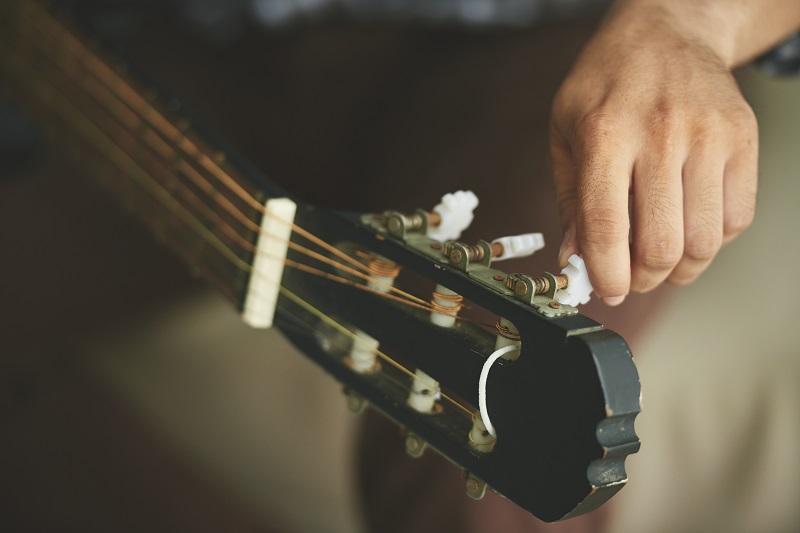What Is the Headstock on a Guitar

Have you ever wondered what the headstock is on a guitar? It's an important component of the instrument, but how does it work and why is it necessary? This article will explore the purpose of a guitar headstock, different types available, its advantages, anatomy, and even customizing options.
Let's take Joe as an example; he recently bought his first electric guitar, but he doesn't know anything about the headstock. With this article, Joe can understand more about how to use and customize his new instrument.
What Is the Purpose of a Guitar Headstock
The purpose of a guitar headstock is to secure the strings and tuning pegs. It accomplishes this by way of its structural design, which helps reduce the weight at the end of the guitar neck while also providing stability for proper tuning.
The headstock holds the tuning pegs in place, which are connected to both ends of the strings. The combination of these components effectively secures the strings so that they do not come loose or move out of tune during playing.
Additionally, many headstocks feature decorative designs that make them visually appealing and unique to each instrument.
Different Types of Guitar Headstocks
You'll find a variety of headstocks on different guitars - some come with six-in-line tuners, others with three-on-a-side. The headstock design is an important factor in the sound and playability of each guitar, as it determines the tension each string has when tuned correctly.
Vintage designs often feature an open or closed slotted headstock to aid in string tensioning. This type of headstock allows for more stability and easier maintenance than most modern designs which are typically bolted together.
Modern designs usually feature what's known as a 'shaft' or 'gear' style which locks the strings into place and helps keep them in tune longer. Additionally, many electric guitars have a unique cutting headstock that makes them stand out from other models.
Overall, there are many types of guitar headstocks available today, so choosing one depends largely on personal preference and playing style.
Advantages of a Headstock
Having a headstock on a guitar offers various advantages for players. One of the main advantages is that it allows for easier stringing than guitars without a headstock. This type of design gives musicians more control over how they can string their instrument, which makes changing strings less time consuming and more secure.
Additionally, having a headstock helps with tuning stability as all the strings are connected to the same point, making them less likely to go out of tune during playing. This is advantageous because it enables players to keep playing in the same key for longer periods of time without needing to retune their guitar frequently.
All in all, having a headstock helps with both stringing method and tuning stability, making it an incredibly useful feature on any guitar.
Guitar Headstock Anatomy
A headstock's anatomy is an important aspect of any guitar, as it affects both stringing and tuning stability. It's crucial to take care in understanding the construction materials and maintenance of a headstock in order to ensure optimal performance.
Generally, the standard design consists of three main components: the head plate, tuners, and string tree. The head plate is typically constructed from wood or metal and provides a stable mount for the tuners. Tuners are usually made from metal and contain gear mechanisms which control pitch when strings are tightened or loosened.
Lastly, a string tree helps to keep strings aligned while playing in higher registers on the guitar neck. All these elements must be properly secured with screws for best results, although some manufacturers opt for locking nuts instead due to their increased durability.
Customizing a Guitar Headstock
Customizing a guitar's headstock is an easy way to make it unique and add your own personal touch! Painting the headstock with a custom color or design of your choice is a great way to express yourself. You can choose from existing designs, like stripes or polka dots, or create your own look with paints, stencils, or airbrushing techniques. Adding decals of logos or symbols is another popular customization option that will give your guitar a unique edge.
When deciding how you'd like to customize the headstock of your guitar, there are lots of creative possibilities available. From painting in colors and patterns to using decals and other embellishments, you can customize the look of your guitar's headstock however you'd like. With some imagination and skillful execution, you'll be able to turn any ordinary guitar into something truly one-of-a-kind!
Conclusion
You've learned what the headstock of a guitar is, its purpose, different types, advantages, and anatomy.
Now it's time to investigate the truth of this theory: that the headstock can make or break the look and sound of your guitar.
By customizing your headstock, you can add unique character to your instrument while also improving its sound.
With the right combination of style, design, and materials, you'll be sure to create a guitar that sounds as great as it looks.
So don't overlook this important part of your instrument – take some time to get creative with customizing your guitar's headstock!






